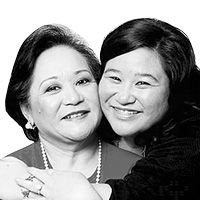The art of sake

MILLIE: I have attended wine and food pairings, yet the most recent and unique was Solaire’s sake and Japanese cuisine food-pairing adventure par excellence! Karla and I were invited to the sneak preview of “The Art of Sake” promotion, which is happening today, Aug. 24, at Solaire’s Yakumi Restaurant.
Sake is an alcoholic beverage of Japanese origin that is made from fermented rice, polished to remove the bran. The four basic ingredients in sake-making are rice, koji, yeast and water.
Sake is more like beer than wine, as sake is produced by brewing and, in the process, converts the starch into sugars that ferment into alcohol, unlike wine, which is produced by fermenting the sugar from grapes.
Sake as a national beverage is served with a special ceremony, usually warmed in a teacup or served chilled.
At the food tasting, the exquisite Japanese fusion dishes created by Yakumi’s executive chef Norimasa Kosaka paired with the finest sake selections recommended by? Solaire’s director for beverage Daniel Blais were definitely non pareil!
As a welcome drink,? we were served a Samurai Sour, a cocktail mix with Japanese? whisky. We were also served chilled, sparkling sake, light and fruity but not as bubbly.
KARLA: If there’s one thing we enjoy about attending these events, it is learning something new. This was our first time to experience a sake pairing. Having someone up close and personal to explain the brewery and the process it had to undergo to produce the finished product makes all the difference. Somehow, you’re able to appreciate the product even more.
Sake is normally served in an ochoko or choko (sake cup); however, that day, we were given wine glasses for the tasting. Blais explained that serving them in wine glasses would allow you to swirl and smell, just as how you would with wine. Using your sense of smell, if the smell pairs well with the food, expect it to naturally pair in taste.
The first course definitely blew us away. In fact, mom had been avoiding crabs and asparagus as a precaution to manage her uric acid. However, that day, she wiped her plate clean. We were offered a generous serving of sake-steamed king crab and sturgeon caviar topped off with asparagus tips, tempura flakes, dashi and a thick, jammy, onsen egg yolk. The dish was paired with Junmai Ginjo Zen, premium sake with a fruity aroma.
MILLIE: The next course was the finest fresh sushi made special with the use of Australian rock lobster tartar, striped jack nigiri and a tuna ceviche, toro sushi and sansho pepper. Every bite was heavenly and I was tempted to ask for seconds.
As a special offering for Solaire’s 10th anniversary, Sake sommelier Rossen Ingco Jr. served us a? glass of Junmai Daiginjo 65% milled sake from the Kagamiyama, Saitama prefecture. Junmai Daiginjo is considered to be the highest grade and the most expensive kind of sake.
The third course was one of my favorites, chawanmushi, a silky and delicate egg custard that chef Nori Kosaka topped with soy-marinated fresh Hokkaido scallop, smoked Spanish mackerel, roasted pine nuts and XO sauce. It was perfect with a glass of chilled Junmai Daiginjo 12.
KARLA: The fourth course was a Patagonian toothfish teppanyaki. Patagonian toothfish is also known as Chilean sea bass, or Antarctic cod. It was served with a generous topping of fresh sea urchin, sake-marinated sancho leaf, and a delicious white soy beurre blanc foam. Delicate flavors from the fish, umami from the sea urchin and rich but light balance from the beurre blanc foam paired with the Junmai Yamadanishiki 65 from Nito, Aichi prefecture.
For the next course, we were served a char-grilled US Prime beef tenderloin with a soy mirin glaze and miso hollandaise, topped with fresh black truffle and served with snow peas and a mushroom rice onigiri on the side. This was paired with Junmai Daiginjo from Hakkaisan, Niigata prefecture, which had been aged in snow for three years. Hakkaisan is located in a snowy region with clear waters from the Hakkaisan river.
For the final course, we were served a green tea roll with adzuki beans and a Japanese plum wine sorbet. This was paired with Umeshu Classic from Choya, Osaka.
Yakumi has expanded its sake selection and is now offering 65 varieties on the menu. Learn more about sake through a guided pairing — a one-night-only Art of Sake special dinner at Yakumi tonight for P6,888+.
Diners will be in for a treat as they will be served seven Solaire-exclusive sakes, including free-flowing sparkling sake and Solaire’s Sake, which was customized for Solaire’s 10th anniversary, where only 600 bottles were produced.
* * *
For more information and reservations, email restaurantevents@solaireresort.com or call +632.8888.8888. Follow Solaire’s social media accounts on Facebook, Instagram, and Twitter at @solaireresort for more event updates.
* * *
Send email to milliereyes.foodforthought@gmail.com and quichethecook.ph@gmail.com
Find us on Facebook: Food for Thought by Millie and Karla Reyes Instagram: @quichethecookph.



















